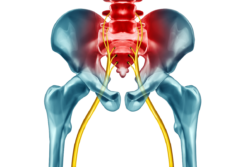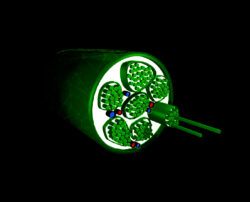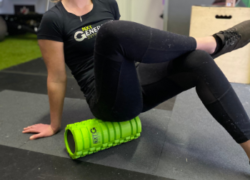Everyone has already heard of the famous sciatic nerve to the point where it becomes almost legendary. But as much as it is responsible for many ailments, many people have only a vague understanding of it. What is its role? And most importantly, what causes the pain it generates?
What is the sciatic nerve?
The sciatic nerve is the longest nerve in our body. It originates from the lower back at the level of the L4 and L5 vertebrae and travels down the back of the legs to the toes. That’s why sciatic pain can radiate from the back of the thigh, through the calf, and down to the foot. Its role? To enable sensitivity and mobility in the lower limbs of the body. In other words, without it, you wouldn’t be able to bend your leg or move your toes. But the problem with such a long nerve is that it is more prone to issues than others.
Les douleurs associées au nerf sciatique sont généralement basées au niveau du dos et descendent vers l’arrière de la jambe. La plupart des personnes décrivent une sensation de brûlure ou un choc électrique. Parfois un engourdissement des membres inférieurs est aussi observé.
What are the causes ?
To find the cause of sciatic nerve pain, one must first understand its functioning. The sciatic nerve can be compared to an electrical wire. There is a conductive wire that is surrounded by an elastic sheath. This sheath allows the nerve to glide through the body, enabling it to function properly. However, sometimes there are small adhesions or stretches on the sheath, which can lead to pain. Therefore, the goal is to restore the glide or relax the nerve.
The sciatic nerve dislikes both tension, as mentioned above, and compression. Indeed, compressing the nerve will reduce its microcirculation, meaning the blood flow within the nerve. Imagine squeezing a garden hose without completely closing it. Less water will come out at the end of the hose. If there are multiple points where the hose is squeezed, even less water will come out. As a result, the nerve will lack oxygen, which can lead to numbness.
It is important to know that a problem with the sciatic nerve is the result of an underlying condition. To resolve it, one must trace it back to the source. Then, it is necessary to determine whether it is inflammation or compression of the nerve. Often, this is due to poor posture, whether during movement or in a stationary position.
How can physiotherapy help you?
The majority of sciatic nerve-related pain will not leave any lasting effects if the patient is promptly treated. In physiotherapy, the first step is to focus on reducing acute pain. Various modalities can be used to decrease the inflammatory phase, including the application of ice. Taking anti-inflammatory medication could be a short-term solution for pain relief. However, since every situation is different, it is advisable to consult your doctor or pharmacist. They alone will be able to determine if this medication can be beneficial for you.
Next, the physiotherapist will work to rehabilitate the posture, restore mobility to immobile joints, and provide exercises to strengthen the lumbar stabilization. The objective is to prevent the recurrence of acute pain.
Often, it is believed that sciatic nerve pain requires surgical intervention. However, it is rather a warning from your body to take better care of it. The role of the physiotherapist will be to reduce the pain and then identify the root cause of your problem in order to fix it once and for all.
If you are experiencing back pain, it may be related to an issue with the sciatic nerve. In that case, please contact us and ask us your questions. Our team will be happy to provide advice and reassurance.




